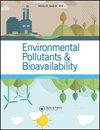离子表面活性剂对粉质壤土的吸附亲和力
Q3 Chemical Engineering
引用次数: 4
摘要
离子表面活性剂由于其广泛的应用,已经被释放或利用到土壤和环境系统中。然而,目前对表面活性剂在土壤上的吸附行为的了解仍然有限。本研究系统地研究了一种阳离子表面活性剂十六烷基三甲基溴化铵(CTAB)和一种阴离子表面活性剂十二烷基硫酸钠(SDS)在粉质壤土上的吸附动力学和等温线,以确定其控制吸附机制。拟二阶速率方程比拟一阶速率方程更能描述吸附动力学数据。实验数据表明,CTAB和SDS分别在24 h和240 h达到吸附平衡。Langmuir方程比Freundlich方程更适合模拟CTAB和SDS在土壤上的吸附等温线。土壤对CTAB的Langmuir最大吸附量远大于对SDS的吸附量。随着实验温度的升高,土壤对CTAB和SDS的吸附量减小。此外,表面活性剂在土壤上的吸附过程是自发的和放热的,由吉布斯自由能和焓绝对值可以看出。结果还表明,物理吸附是两种表面活性剂在土壤上的主要吸附机制。这项工作的发现对于理解离子表面活性剂的环境行为至关重要。本文章由计算机程序翻译,如有差异,请以英文原文为准。
Sorptive affinity of ionic surfactants on silt loamy soil
Abstract Due to their broad applications, ionic surfactants have already been released into or utilized in soil and environmental systems. However, current understanding on the sorption behavior of surfactants onto soils is still limited. This work systematically investigated the sorption kinetics and isotherms of one cationic surfactant, cetyltrimethylammonium bromide (CTAB), and one anionic surfactant, sodium dodecyl sulfate (SDS), onto a silt loamy soil to determine the governing sorption mechanisms. The pseudo-second-order rate equation described the sorption kinetics data better than the pseudo-first-order rate equation. Experimental data showed that the sorption equilibrium for CTAB and SDS were reached at 24 and 240 h, respectively. Langmuir equation was better than Freundlich equation in simulating the sorption isotherms of CTAB and SDS on the soil. Soil Langmuir maximum sorption capacity of CTAB was much higher than that to SDS. When the experimental temperature increased, the sorption of CTAB and SDS on the soil decreased. In addition, the sorptive process of the surfactants on the soil was spontaneous and exothermal, as indicated by the absolute values of Gibbs free energy and enthalpy. The results also indicated that physical sorption was the dominant mechanism for the sorption of the two surfactants on the soil. Findings from this work are crucial to understand the environmental behaviors of ionic surfactants.
求助全文
通过发布文献求助,成功后即可免费获取论文全文。
去求助
来源期刊
CiteScore
1.62
自引率
0.00%
发文量
0
审稿时长
1 months
期刊介绍:
Chemical Speciation & Bioavailability ( CS&B) is a scholarly, peer-reviewed forum for insights on the chemical aspects of occurrence, distribution, transport, transformation, transfer, fate, and effects of substances in the environment and biota, and their impacts on the uptake of the substances by living organisms. Substances of interests include both beneficial and toxic ones, especially nutrients, heavy metals, persistent organic pollutants, and emerging contaminants, such as engineered nanomaterials, as well as pharmaceuticals and personal-care products as pollutants. It is the aim of this Journal to develop an international community of experienced colleagues to promote the research, discussion, review, and spread of information on chemical speciation and bioavailability, which is a topic of interest to researchers in many disciplines, including environmental, chemical, biological, food, medical, toxicology, and health sciences.
Key themes in the scope of the Journal include, but are not limited to, the following “6Ms”:
Methods for speciation analysis and the evaluation of bioavailability, especially the development, validation, and application of novel methods and techniques.
Media that sustain the processes of release, distribution, transformation, and transfer of chemical speciation; of particular interest are emerging contaminants, such as engineered nanomaterials, pharmaceuticals, and personal-care products.
Mobility of substance species in environment and biota, either spatially or temporally.
Matters that influence the chemical speciation and bioavailability, mainly environmentally relevant conditions.
Mechanisms that govern the transport, transformation, transfer, and fate of chemical speciation in the environment, and the biouptake of substances.
Models for the simulation of chemical speciation and bioavailability, and for the prediction of toxicity.
Chemical Speciation & Bioavailability is a fully open access journal. This means all submitted articles will, if accepted, be available for anyone to read, anywhere, at any time. immediately on publication. There are no charges for submission to this journal.

 求助内容:
求助内容: 应助结果提醒方式:
应助结果提醒方式:


